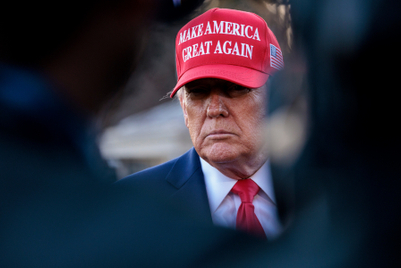
Hours after announcing his sweeping ‘Liberation Day’ reciprocal tariffs, US President Donald Trump took to Truth Social to declare, with characteristic flair, that "the operation is over," and that "the patient lived, and his healing." It was a statement loaded with drama, but behind the theatrics lies a policy move that could send tremors through the global economy, and by extension, the advertising and marketing sector squarely in the line of fire.
The term ‘Liberation Day’ is Trump’s rhetorical attempt to position his administration’s new tariff regime as an act of economic self-rescue. According to him, the US has long been shackled by its own generosity—offering easy access to the world’s richest consumer market while getting little in return.
— Donald J. Trump (@realDonaldTrump) April 3, 2025
As per Barron’s, the US recorded a trade deficit of $918 billion in 2024—marking a sharp 59% jump from the $576 billion gap it posted in 2019. The largest chunk of this imbalance came from China, which maintained a surplus of $295.4 billion in goods trade with the U.S. over the same period.
With this trade deficit looming large, Trump invoked the International Emergency Economic Powers Act of 1977 to address “the national emergency” as The White House termed it. He then rolled out tariffs on more than 180 countries—no exclusions, no favourites.
India was handed a 27% reciprocal tariff; a figure Trump claims is just half of what New Delhi charges the US. Also on the list was a 25% tariff on automobile imports to America.
Standing at the Rose Garden, Trump said, "The Prime Minister just left. He's a great friend of mine. But I said, 'You're a friend of mine, but you haven't been treating us right'. They charge us 52 per cent, but we charge them almost nothing for years and decades. It was only seven years ago when I came in."
If this sounds personal, it probably is. But policy rarely plays favourites, and these new tariffs could ripple through sectors far beyond trade and manufacturing. For India, and especially for brands, marketers and agency heads, the coming months may be less about crisis management and more about navigating a new normal.
Beyond the numbers: The realpolitik of tariffs
More than a blunt economic tool, tariffs have historically been about leverage—a way to extract concessions from trading partners, rather than spark all-out trade wars. Trump’s tariff policy is calibrated to signal toughness. But while it may play well to domestic political bases, the global reaction has been less enthusiastic.
The 27% tariff on India is not excessive compared to tariffs on other countries like China (34%), Vietnam (46%), South Korea (25%) and the EU (20%). All these nations are contending with the consequences of this tumult and the wider market is expected to face short-term turbulence.
“With tariffs now spanning several regions, global input costs are set to rise—potentially fuelling inflation in the U.S. and muddying the Federal Reserve’s path toward anticipated rate cuts, which investors had been counting on. In the days ahead, unpredictability is likely to dominate the global financial landscape,” said Apurva Singhi, founder of a financial services firm.
Some see this as a strategic opening for negotiation rather than retaliation. Yet, even a temporary tariff can distort trade patterns, shift investment flows and rattle sectoral equilibrium.
Who pays, who gains, who ducks
While pharmaceuticals have largely dodged the bullet, India’s gems and jewellery sector might not be as lucky. And therein lies the first real challenge: how do affected sectors absorb the blow?
Beneath the surface, the bigger threat of the tariff announcements lies in services. India’s trade in goods with the US is substantial, but it’s the services sector—especially IT and IT-enabled exports—that forms the backbone of its economic soft power. Global capability centres, offshore R&D hubs, and tech support functions all rely on an open channel to the American market.
This is not just about jobs or forex. It’s about opportunity. These service exports offer a path to upward mobility for a broad segment of India’s workforce. If tariffs expand beyond goods and spill over into services, it could derail more than just trade—it could disrupt livelihoods.
Retaliation, in this context, might be a short-sighted move. As one industry insider noted, dragging services into a tit-for-tat game would be a strategic misstep.
Tariffs are, after all, taxes on imports. The burden may fall on exporters, or be passed on to American consumers—either way, someone pays.
"Applying tariffs across the board often triggers unforeseen ripple effects. Smaller developing nations end up subject to the same duties as major industrial powerhouses, erasing distinctions between vastly different economies. The result? Consumers face steeper prices, and businesses are saddled with higher operational costs," noted a marketing head at a jewellery company.
This one-size-fits-all strategy also complicates things for Indian exporters. Should they rework their financial forecasts, cut marketing costs, or absorb losses in the short-term? These are not theoretical questions—they’re boardroom agendas across sectors.
Uncertainty doesn’t advertise well
For the advertising and marketing ecosystem, uncertainty is a dealbreaker. Brands with exposure to the US—whether through exports, manufacturing, or service delivery—are likely to be cautious, if not conservative, in their planning.
"Sectors like retail and consumer electronics, heavily reliant on imports, are likely to curtail ad spend. Digital platforms such as Meta and Google, which depend on advertising revenue from these industries, may experience slower growth. Additionally, increased costs for tech equipment could delay infrastructure projects, affecting advertising operations. Overall, the tariffs introduce economic uncertainty, prompting brands to reassess and potentially scale back their marketing investments,” said Yasin Hamidani, Director, Media Care Brand Solutions.
This hesitancy is exacerbated by an already cautious advertising climate. In the post-pandemic era, marketers have been scrutinising return on ad spend (ROAS) like never before. As brands shift more functions in-house and consumers fragment across platforms, the ad dollar isn’t just being squeezed—it’s being dissected.
The logical pivot, then, is towards performance marketing, where companies lean towards performance-based advertising models that allow them to adjust their ad spend quickly in a dynamic and unpredictable landscape.
Ambika Sharma, founder and chief strategist of Pulp Strategy expects digital ad spends—especially on US-owned platforms like Google and Meta—to see a recalibration. While this might not necessarily result in a pullback necessarily, it could see brands take a more measured, performance-driven approach where they justify the ROI on every rupee spent.
“This geopolitical moment may also spark a shift in narrative. We’ll see more ‘Made in India’ messaging, nationalistic pride, and value-driven storytelling surface across campaigns—especially in export categories trying to maintain consumer confidence while defending pricing,” she added. “With the removal of the equalisation levy, there was brief relief. But now, with rising trade friction, marketers are rethinking their platform mix. This is a strong moment for Indian brands to diversify—invest more in homegrown platforms, regional influencer ecosystems, and creator-led commerce models that offer better agility and cost control.”
That said, the industry is still heavily reliant on global tech for reach and scale. So, the change won’t be overnight. However, the shift in mindset has begun. Translation: brand building might take a back seat, hence, expect tighter campaign cycles, smaller experimental budgets, and sharper KPIs.
Investment anxiety and the global trust deficit
If Trump’s goal is to re-shore American manufacturing and protect domestic jobs, the unintended outcome could be the opposite. By introducing unpredictability into the system, the US risks eroding the very trust that has made it a magnet for global capital.
Multinational corporations crave stability. If they sense that American trade policy is one executive order away from chaos, they may start re-routing investments to friendlier, more stable jurisdictions. India stands to gain here—but only if it plays its cards right.
And let’s not forget the domino effect. Leaders in Europe, Canada, and China are already drafting their response playbooks. If the current wave of tariffs leads to a tit-for-tat spiral, the fallout could include rising prices, disrupted supply chains and further economic fragmentation.
Treasury Secretary Scott Bessent tried to cool nerves on CNN, saying, “One of the messages that I’d like to get out tonight is everybody sit back, take a deep breath, don’t immediately retaliate, let’s see where this goes. Because if you retaliate, that’s how we get escalation.”
The real question for India isn’t just whether to retaliate—but how. Is it better to strike back or to step back? Can India use this moment to reposition itself as a reliable trade partner to countries looking to hedge against US volatility? Could it help shape a new trade architecture, one less dependent on Washington’s whims?
These are not rhetorical musings. They’re strategic imperatives. For now, the focus for the advertising and marketing industries should be on navigating the volatility, staying nimble with spend, and scenario-planning for longer-term shifts in global trade dynamics.
Because in a world where economic policy can shift overnight via a social media post, agility is not just a buzzword—it’s survival strategy.


.jpg&h=268&w=401&q=100&v=20250320&c=1)
.jpg&h=268&w=401&q=100&v=20250320&c=1)




.jpg&h=268&w=401&q=100&v=20250320&c=1)
.jpg&h=268&w=401&q=100&v=20250320&c=1)
